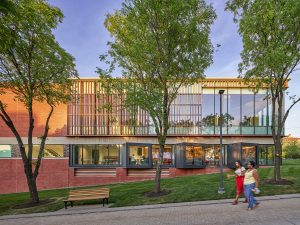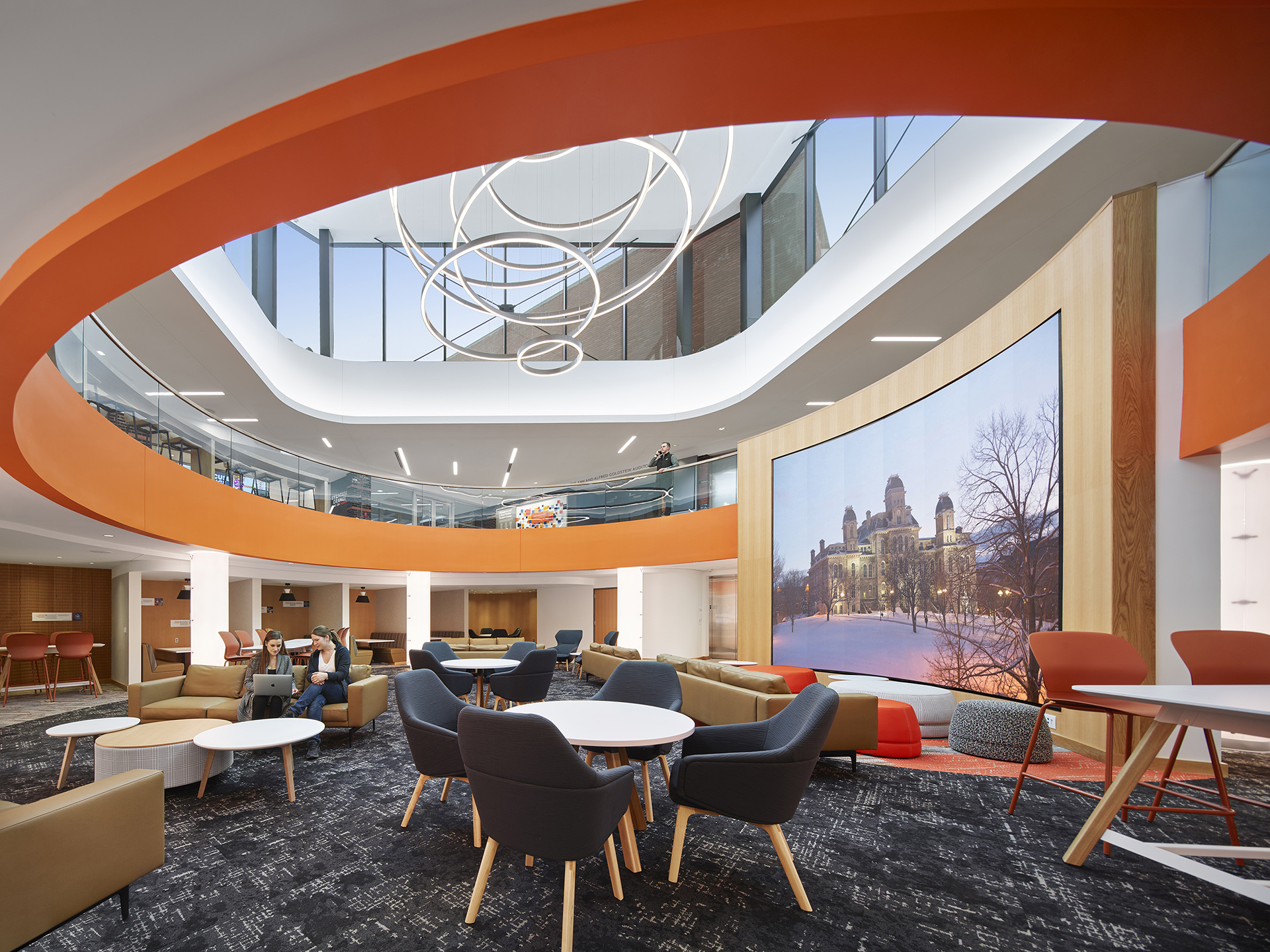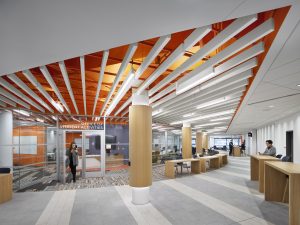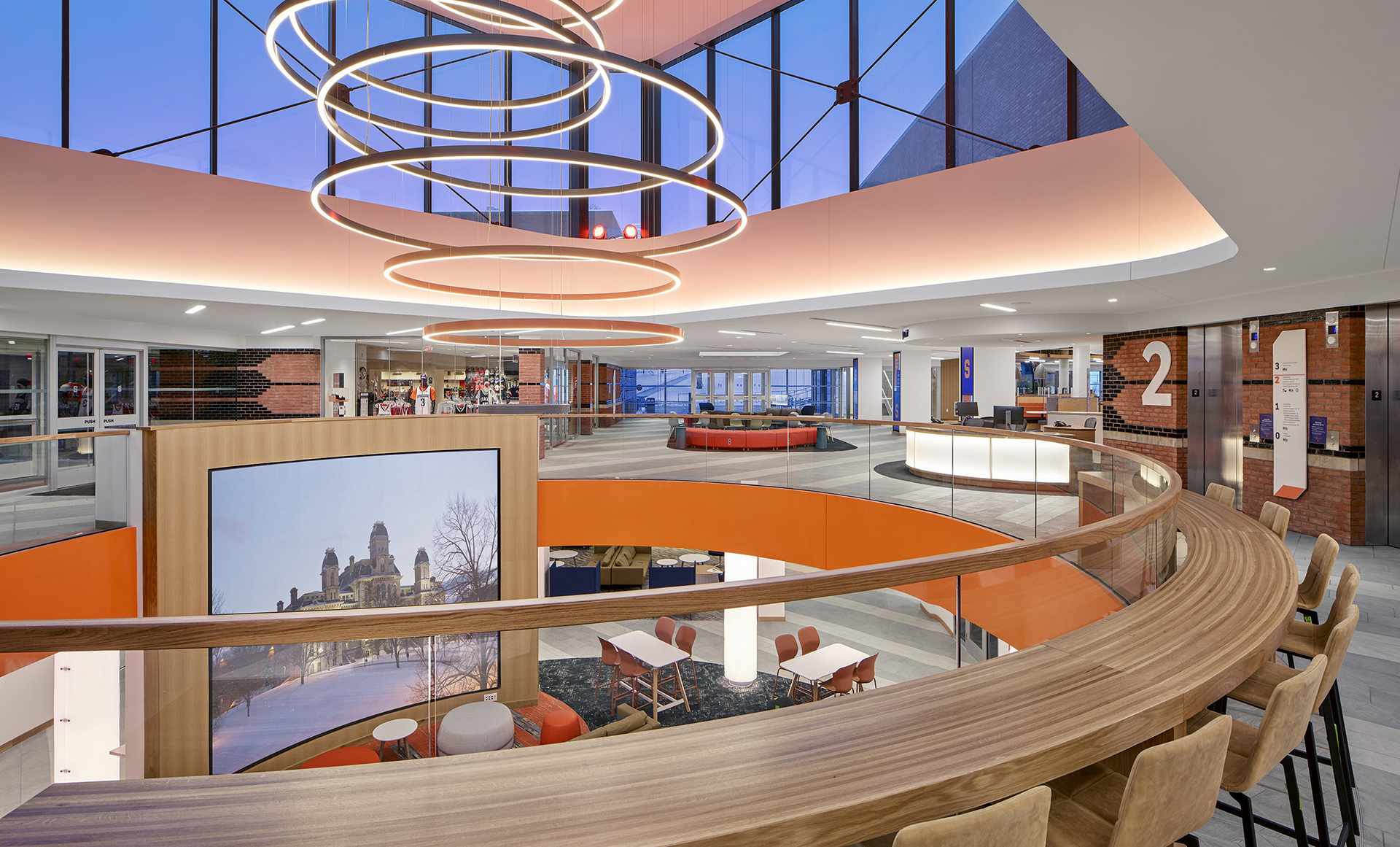
The Schine Center
Integrating today’s changing trends and expectations into renovations can be daunting. Doing so means not only transforming physical spaces, but also changing the way students engage through the lenses of diversity, equity, and inclusion. Syracuse University faced this challenge as they approached the substantial renovation of their campus student center. By bringing three key design elements together—universal design, student-centered design, and design for diversity and inclusion—Syracuse University’s Schine Center embodies a dramatic shift in focus, creating a vibrant, inclusive new space for the campus.
The Schine Student Center’s original opening in 1985 was the answer to a question 75 years in the making: How to create the perfect place for students to come together, which traces back to a 1911 Daily Orange editorial demanding a student center be built. Prior to 1985, there had simply been nothing like it on campus.
From Closed-Off Places to Wide-Open Spaces
However, after three decades of service, Schine had lost relevancy and vigor. It faced significant hurdles: confusing circulation, hard-to-find student support program spaces, an outdated dining model, and poor accommodation of those with differing abilities and backgrounds. The building was closed off, convoluted, and opaque. The brick and center stair actually discouraged visitors from exploring the building.
In 2021, the Syracuse University alumni-led team of Mackey Mitchell Architects and Ashley McGraw Architects completed the 108,000-sq.-ft. renovation, which was identified as a key component of the Campus Framework, the university’s 20-year plan for development. The center now provides a welcoming hub, enabling easy connection with resources and activities. Schine’s transformation embodies the nexus of three design principles: universal design, student-centered design, and design for diversity and inclusion. “People with varying identities should be able to go into Schine and see themselves in the physical space and in the people inhabiting that space,” explains Meredith Davis, associate vice president of student engagement. “Intersectionality creates an experience that is personalized and holistic.”
Despite the challenges, Schine had good “bones”—a sold chassis that could lend itself to loft-like openness. Programming and design strategies included prioritizing and expanding student-centered spaces and relocating non-student-facing functions elsewhere. A wide variety of spaces to relax and socialize were distributed through Schine’s many levels. Wherever feasible, walls were removed to create openness and connectivity.
Heart Surgery: The Atrium Is Revitalized
Major surgery was completed on Schine’s atrium, replacing a tired pyramid skylight with a lantern-like clerestory providing views to the sky. John Burse, principal of Mackey Mitchell Architects, explains, “One becomes a sort of surgeon specializing in improving the vitality of social hearts of campuses. As designers, we really need to understand the student experience. How are students living their lives on campus? How are they interacting with the building? Where is it stacking up well and where is it falling short?” Able to be seen from across campus, the clerestory’s lighting is dramatic and can change color to reflect the spirit of the day.

Schine Center: Atrium main level.
“The design team conceived the new central atrium as a boomerang that pulls students from outside campus into campus,” explains Susanne Angarano, principal at Ashley McGraw Architects. “The center of the boomerang is the atrium, the hub of all the activity.” A large media wall anchors this space with a focal point for gatherings, announcements, or game-day watch parties. The atrium’s curving geometry creates unity as well as sense of belonging. As the heart of the center, this spirited crossroads comes alive for lounging, conversations, and programming.
Transforming Spaces = Transforming Experiences
“The people, spaces, and services within this building undoubtedly shape the student experience,” says Robert Hradsky, Syracuse vice president for the student experience. “That is why, throughout this renovation, connecting with students about what they envisioned for this space was so important. Not only have these physical spaces been transformed, but the activities, experiences, and programs will also be transformed, changing the way students engage on campus.”

Schine Center: Intercultural Collective Suite.
Because food fosters community, dining was transfigured into a memorable destination offering seating options ranging from see-and-be seen to intimate nooks and crannies, including sought-after “booth-bay boxes” that rotate out from the building’s exterior to frame views of the campus’s iconic Hall of Languages. In short, there is a place for everyone. Dining offerings are rich and varied. An outdoor terrace connects the warm, friendly interiors with pedestrian activity along the Einhorn Family Walk.
Flexible coworking-styled spaces provide an engaging setting that showcases resources, activities, and organizations, creating an irresistible invitation to get involved or to lead something new. The expanded atrium provides these centers with enhanced visibility, endowing Schine’s visitor experience with a dash of serendipity—you can find things you didn’t even know you were looking for.
The spirit of openness was also extended to the exterior. Strategic expanses of the masonry facade were peeled back for installation of larger glazed sections, bringing natural light to interior lounge spaces and visually extending the campus fabric to the newly renovated interiors.
Concurrently, thanks to an expansive reconfiguration of the building interior, the masonry backup wall was exposed, facilitating interior installation of a fluid-applied air barrier for the full extent of the building facade. This addition significantly reduced air infiltration through the building envelope, allowing the upgraded HVAC systems to function at maximum efficiency. The resulting renovation is a significant asset for the campus community in both function and performance.
The University’s Living Room

Schine Center: Office of Student Activities.
Embracing these principles, Schine has been transformed from a transactional destination to an inclusive, vibrant campus living room. The center’s increased openness enables improved circulation, wayfinding, and accessibility, embodying the key principles of universal design. Prior to the renovation, vital student activities and resources were undersized, hard to find, or located elsewhere on campus. Improving student ability to discover these opportunities was important to increase engagement, and also critical to advancing inclusion and equity. Student-facing services and student organization offices are now prioritized and highly visible, along with a key grouping of cultural centers, all of which allow deeper, connected conversations around the many intersections of student identities.
Accessibility was enhanced by installing automatic openers on exterior public doors, smoothing floor transitions, incorporating accessible signage, installing universally accessible counter and work-surface heights, providing fully accessible restrooms on each level, and upgrading elevators. Schine sits on an imposing slope of Syracuse’s hilltop campus. Overcoming this barrier, the renovation provides not just an accessible pathway but a campus gateway for all.
As Chancellor Kent D. Syverud said at the center’s grand reopening ribbon-cutting ceremony, “The term ‘renovation’ really doesn’t begin to capture what has been done here. More than a renovation, this is really a reimagining. This is the university’s living room, and it is a completely student-centered living room. This is the experience that our students asked for and that our students really deserve.”
Calvin Ahn is principal of Ashley McGraw Architects, based in Syracuse, NY; he can be reached at [email protected]. John Burse is principal of Mackey Mitchell Architects, based in St. Louis, MO; he can be reached at [email protected]. This is their first article for Facilities Manager.



